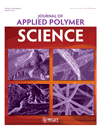Fabrication and morphology development of isotactic polypropylene nanofibers from isotactic polypropylene/polylactide blends
Abstract
The excellent characteristics of polymeric nanofibers with diameters less than 1 μm such as the enormous specific surface result in a dramatic increase in a variety of functional applications. In this article, polymer blends of isotactic polypropylene (iPP) and polylactide (PLA) were fabricated through a twin-screw extruder. The extrudates were prepared at various processing conditions and the iPP nanofibers were obtained by removal of the PLA matrix from the drawn samples. The influences of drawing ratio, the processing temperature, and the blend ratio of iPP/PLA on the morphology development of iPP phase were investigated by scanning electron microscopy. It was found that the uniformed iPP nanofibers with averaged diameters less than 500 nm were fabricated by the suitable processing parameters. Otherwise, the processing immiscibility and rheological behavior of iPP/PLA blends were studied by means of dynamic mechanical analysis and capillary rheometer. © 2011 Wiley Periodicals, Inc. J Appl Polym Sci, 2012




